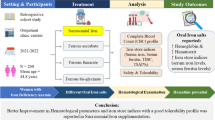Purpose.
Ascorbic acid was administered to patients with chronic hepatitis C to elucidate the mechanism of onset of retinopathy during interferon (IFN) therapy, and its prevention. Methods. The subjects were 62 patients with chronic hepatitis C who had been admitted to our hospital. For the IFN therapy, 6 MIU of natural IFN-α or 10 MIU of recombinant human IFN-α 2b was administered every day for the first 2 weeks, followed by administration three times a week for 22 weeks. The patients were randomly assigned to a group receiving 600 mg/day of ascorbic acid or a group not receiving ascorbic acid (control group). The optic fundi were examined by ophthalmologists before the IFN therapy began and subsequently at weeks 2 and 4 and then every 4 weeks during the IFN therapy. Results. Retinopathy was found in 9 of the 31 patients (29%) in the ascorbic acid-treated group and in 11 of the 31 patients (35%) in the control group. The cumulative incidence of hemorrhage in the ascorbic acid-treated group was lower than that in the control group during the IFN therapy, but the difference between the two groups was not significant (P = 0.186). The cumulative incidence of cotton-wool spots in the ascorbic acid-treated group was almost same as that in the control group during the IFN therapy. The median platelet counts before the therapy was begun were 11.8 × 104/mm2 in the group with hemorrhage and 16.6 × 104/mm2 in the group without, and the lowest platelet counts during IFN therapy were 7.3 × 104/mm3 in the group with hemorrhage and 9.5 × 104/mm3 in the group without, indicating significantly lower values in the group with hemorrhage (P = 0.018 and P = 0.020, respectively). The lowest platelet counts during IFN therapy were 7.4 × 104/mm3 in the group with cotton-wool spots and 9.7 × 104/mm3 in the group without, indicating a significantly lower value in the group with cotton-wool spots (P = 0.036). Conclusions. Ascorbic acid was not considered to be useful for the prevention of the retinopathy associated with IFN therapy in patients with chronic hepatitis C.
Similar content being viewed by others
Author information
Authors and Affiliations
Additional information
Received: September 14, 2000 / Accepted: January 19, 2001
Rights and permissions
About this article
Cite this article
Nishiguchi, S., Shiomi, S., Enomoto, M. et al. Does ascorbic acid prevent retinopathy during interferon therapy in patients with chronic hepatitis C?. J Gastroenterol 36, 486–491 (2001). https://doi.org/10.1007/s005350170072
Issue Date:
DOI: https://doi.org/10.1007/s005350170072




